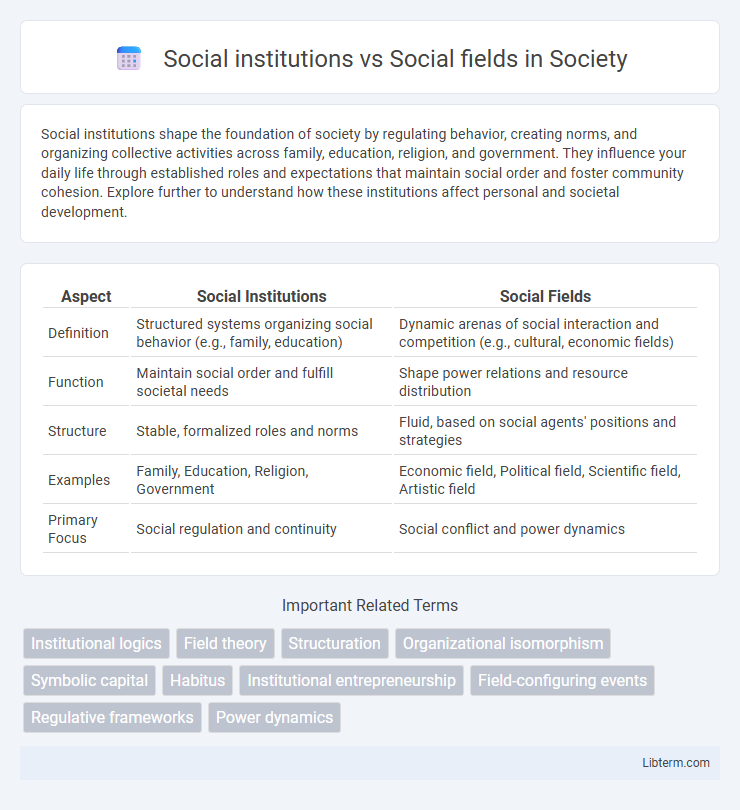Social institutions shape the foundation of society by regulating behavior, creating norms, and organizing collective activities across family, education, religion, and government. They influence your daily life through established roles and expectations that maintain social order and foster community cohesion. Explore further to understand how these institutions affect personal and societal development.
Table of Comparison
| Aspect | Social Institutions | Social Fields |
|---|---|---|
| Definition | Structured systems organizing social behavior (e.g., family, education) | Dynamic arenas of social interaction and competition (e.g., cultural, economic fields) |
| Function | Maintain social order and fulfill societal needs | Shape power relations and resource distribution |
| Structure | Stable, formalized roles and norms | Fluid, based on social agents' positions and strategies |
| Examples | Family, Education, Religion, Government | Economic field, Political field, Scientific field, Artistic field |
| Primary Focus | Social regulation and continuity | Social conflict and power dynamics |
Defining Social Institutions
Social institutions are structured systems of established norms, roles, and practices that organize and regulate key societal functions such as family, education, religion, and government. They provide stability and continuity by prescribing expected behaviors and relationships within a community. Unlike social fields, which refer to dynamic spaces of social interaction and competition, social institutions represent enduring frameworks that shape collective life and individual conduct.
Understanding Social Fields
Social fields are structured arenas where individuals and groups interact based on shared interests, power relations, and resources, shaping social dynamics beyond formal rules typical of social institutions. Unlike social institutions, which are established systems with specific norms and roles, social fields emphasize ongoing negotiations and competition among actors seeking to influence the distribution of capital, status, and opportunities. Understanding social fields involves analyzing patterns of social interaction, power struggles, and cultural capital that determine access and control within a given social space.
Historical Development of Social Institutions
Social institutions, such as family, education, and religion, have evolved over centuries, reflecting the cultural, economic, and political changes in societies. Their historical development is marked by adaptation to technological advancements and shifting social norms, which has shaped their structure and functions. In contrast, social fields represent dynamic networks of relationships and power interactions within specific areas, emphasizing ongoing social processes rather than fixed institutional frameworks.
Evolution of Social Fields
Social fields evolve through dynamic interactions among actors, rules, and resources, reflecting shifts in power and cultural norms that redefine social institutions. Unlike static social institutions, social fields are fluid arenas where innovation, conflict, and collaboration drive continuous transformation. This evolution emphasizes adaptability and complexity in understanding how social structures respond to changing societal demands.
Key Characteristics of Social Institutions
Social institutions are structured systems of established norms and roles that regulate behavior within a society, such as family, education, and religion, characterized by stability, continuity, and collective acceptance. They possess formal rules and behaviors that fulfill basic societal needs and maintain social order over time. Unlike social fields, which are dynamic arenas of social interaction influenced by individual agency and competition, social institutions provide a stable framework guiding consistent social practices.
Core Features of Social Fields
Social fields are dynamic spaces characterized by patterns of social interaction, power relations, and continuous competition among actors seeking to influence outcomes within distinct arenas such as education, politics, or art. Unlike social institutions, which are established and structurally stable systems governed by formal rules and norms, social fields emphasize fluidity, struggle, and the strategic positioning of individuals or groups. Core features of social fields include the presence of specific stakes valued by participants, relational interdependencies, and a shared understanding of the rules of engagement that shape actors' behaviors and possibilities for change.
Functions of Social Institutions in Society
Social institutions such as family, education, religion, and government perform essential functions in society by regulating behavior, maintaining social order, and fulfilling key societal needs like socialization, cultural transmission, and governance. These institutions provide structured roles and norms that help stabilize and organize societal interactions, ensuring continuity and cohesion. Unlike social fields, which represent dynamic arenas of power and competition, social institutions offer established frameworks that sustain collective life and facilitate cooperation.
Roles of Social Fields in Social Structure
Social fields function as dynamic arenas where various actors interact, compete, and cooperate, shaping social norms and power relations within the broader social structure. These fields influence individuals' behaviors and opportunities through the distribution of capital--economic, cultural, and social--impacting social stratification and mobility. Unlike social institutions, which provide stable frameworks and norms, social fields represent fluid spaces of social action that continuously redefine roles and hierarchies in society.
Differences Between Social Institutions and Social Fields
Social institutions are structured and established systems with specific rules, roles, and norms, such as family, education, and religion, that organize societal functions. Social fields, in contrast, refer to dynamic arenas of social life where individuals and groups compete for power, resources, and status, often shaped by ongoing interactions and struggles. The key difference lies in social institutions being formalized frameworks, while social fields emphasize the fluid and competitive nature of social relations and positions within society.
Interactions Between Social Institutions and Fields
Social institutions, such as family, education, and religion, establish structured norms and roles that guide individual behavior, while social fields represent dynamic arenas of social interactions where power and resources are contested and negotiated. The interactions between social institutions and social fields shape societal dynamics as institutions provide the institutionalized frameworks within which fields operate, influencing behavior, strategies, and social outcomes. These engagements lead to continuous adaptation of institutional norms and reconfiguration of social fields, highlighting the reciprocal influence between stable structures and fluid social practices.
Social institutions Infographic

 libterm.com
libterm.com